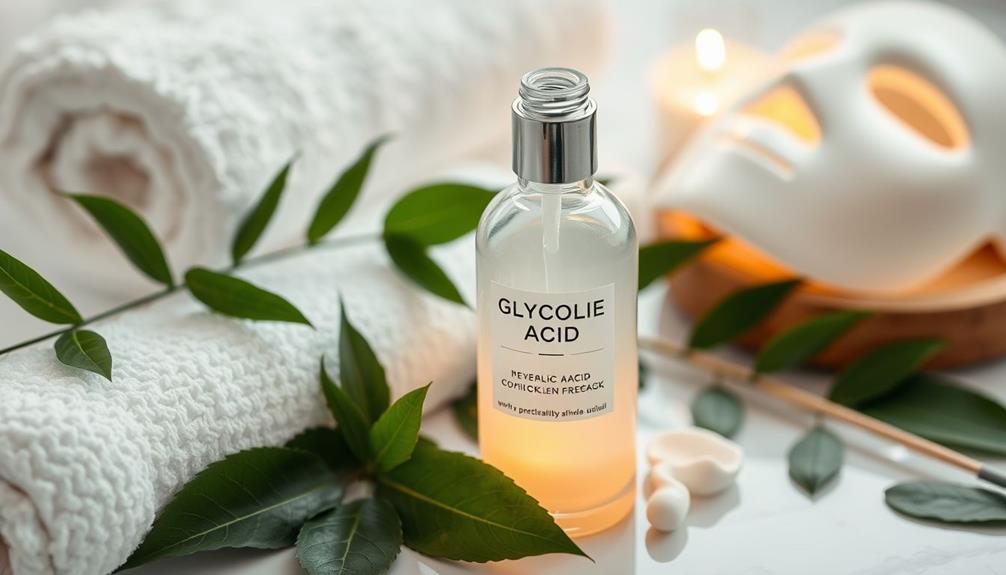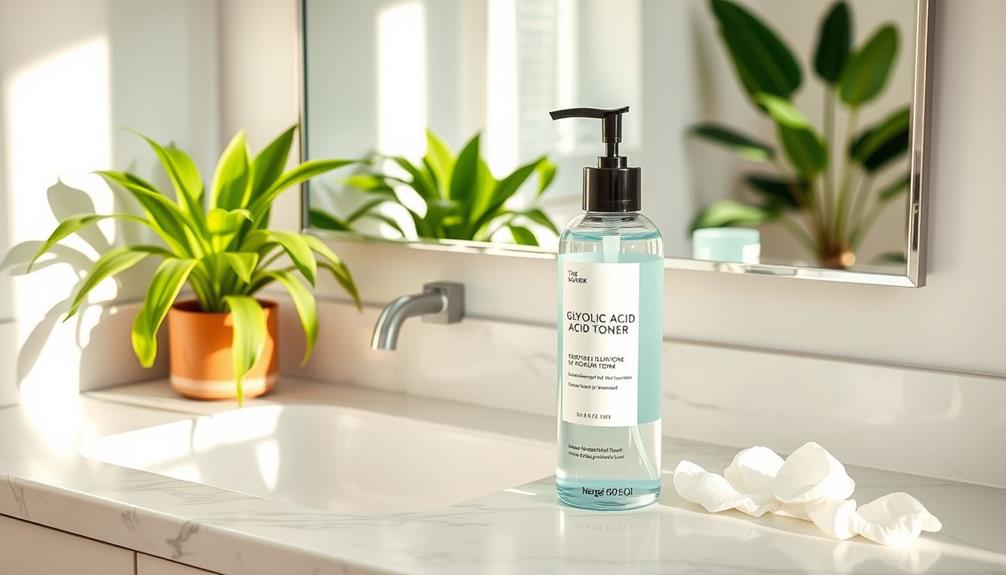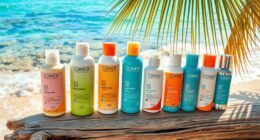Using a 10% concentration of glycolic acid can have amazing benefits for your skin. It helps to increase cell turnover, which can unclog pores, reduce breakouts, and fade acne scars over time. These effects can make your skin look clearer and more even. In addition, glycolic acid stimulates collagen production, which can minimize fine lines and improve skin elasticity for a youthful appearance. It also enhances skin texture, leaving you with a smoother and brighter complexion. It is important to start slowly when incorporating glycolic acid into your routine and to use sunscreen daily, as it can increase sensitivity to the sun. If you’re interested in learning more about the specific benefits and tips for using glycolic acid, there is more information to explore!
Key Takeaways
- 10% glycolic acid effectively exfoliates, promoting cell turnover for smoother, brighter skin and improved overall texture.
- It reduces acne breakouts by unclogging pores and preventing the formation of blackheads and whiteheads.
- Regular use can fade acne scars and hyperpigmentation, leading to a more even skin tone over time.
- The formulation boosts collagen production, diminishing fine lines and enhancing skin elasticity for a youthful appearance.
What Is Glycolic Acid?
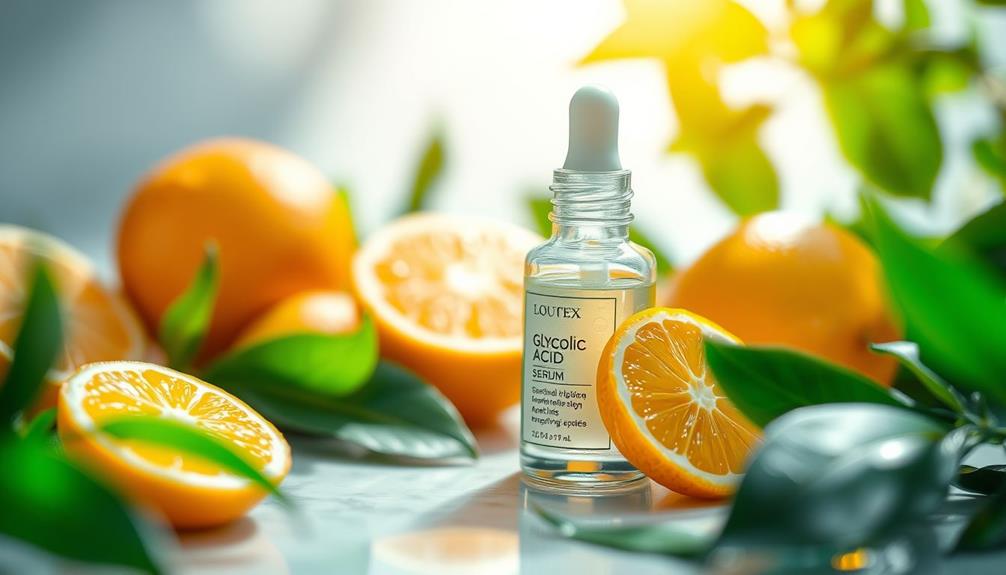
Glycolic acid is a powerful exfoliant, frequently derived from sugarcane, that effectively rejuvenates your skin. As one of the most popular alpha hydroxy acids (AHAs), glycolic acid has the smallest molecular structure, allowing it to penetrate deeply and work efficiently.
When you use products containing glycolic acid, you're engaging in an effective exfoliation process that promotes cell turnover. This process helps to dissolve dead skin cells, revealing a brighter and smoother complexion. Incorporating natural ingredients such as essential oils for skin health can further enhance your skincare routine by providing additional nourishment and antimicrobial benefits.
Typically, glycolic acid is found in concentrations ranging from 5% to 15%, making it suitable for various skin types and concerns. By incorporating glycolic acid into your skincare routine, you can enhance your skin texture and overall appearance.
It not only aids in sloughing off dead skin but also stimulates collagen production, which is crucial for maintaining skin elasticity and firmness. Additionally, glycolic acid has humectant properties that help in attracting and retaining moisture, contributing to hydration.
Benefits for Acne Treatment

When you're dealing with acne, glycolic acid can be a game changer.
It not only reduces breakout frequency but also effectively unclogs pores to keep your skin clear.
Incorporating consistent skincare practices, such as mindful eating, can further enhance your skin's overall health.
Plus, regular use can help fade those pesky acne scars over time.
Reduces Breakout Frequency
With its powerful exfoliating properties, glycolic acid effectively reduces the frequency of breakouts by preventing clogged pores and promoting clearer skin. When you use glycolic acid, you help your skin shed dead skin cells that can accumulate and contribute to acne. This exfoliation is essential since clogged pores are a primary cause of breakouts.
Additionally, maintaining a clean environment with proper air quality can enhance your skincare efforts, as air purifiers help reduce allergens and pollutants that may irritate the skin.
Studies show that formulations with as little as 5% glycolic acid can greatly reduce mild to moderate acne in individuals aged 12 and older. By increasing cell turnover, glycolic acid not only helps prevent new breakouts but also improves the overall texture of your skin. Regular use means fewer blemishes and less severe outbreaks over time.
Moreover, glycolic acid aids in fading post-acne marks and hyperpigmentation, giving you a clearer complexion. As you incorporate this ingredient into your skincare routine, you'll notice a decrease in the frequency of acne flare-ups.
Unclogs Pores Effectively
Unclogging pores effectively, glycolic acid works to dissolve the bonds between dead skin cells, paving the way for clearer, healthier skin.
With its small molecular size, glycolic acid penetrates deeply, targeting the root causes of acne. As you incorporate it into your skincare routine, you'll notice a significant reduction in comedonal acne, thanks to its ability to promote cell turnover. Even concentrations as low as 5% can make a difference, helping you to unclog pores and prevent future blockages.
Additionally, using products with essential oils can enhance skin clarity and provide soothing benefits.
Regular use of glycolic acid can help diminish the formation of pesky blackheads and whiteheads, enhancing your overall skin clarity. By gently exfoliating the outer layer of your skin, it minimizes the visibility of enlarged pores, leading to a smoother texture you'll love to show off.
Plus, glycolic acid's antibacterial properties inhibit the growth of acne-causing bacteria, contributing to a clearer complexion.
Incorporating glycolic acid into your routine isn't just about clearer skin; it's about reclaiming your confidence and enjoying the benefits of healthier, radiant skin.
Fades Acne Scars
Glycolic acid not only clears pores but also effectively fades acne scars by promoting cell turnover and smoothing skin texture. When you incorporate glycolic acid into your skincare routine, you stimulate collagen production, which helps heal and plump the skin, reducing the visibility of scars. Studies show that using glycolic acid peels in conjunction with microneedling can greatly enhance results, especially for post-acne scarring.
Here's a quick overview of the benefits of glycolic acid for fading acne scars:
| Aspect | Details |
|---|---|
| Effectiveness | Fades both superficial and deeper scars |
| Recommended Concentration | 5% to 10% for visible improvements |
| Mechanism | Promotes cell turnover and exfoliates the skin |
| Combination Treatments | Works well with microneedling for enhanced results |
Incorporating glycolic acid into your skincare routine can lead to smoother, clearer skin over time, making it a versatile option for anyone dealing with acne scars. Give it a try and watch your skin transform!
Anti-Aging Properties

The anti-aging benefits of glycolic acid are impressive, as it boosts collagen production to enhance skin elasticity and diminish fine lines.
When you incorporate glycolic acid into your skincare routine, you'll notice a significant improvement in your skin's firmness and overall texture. This powerful ingredient stimulates the synthesis of collagen, which helps keep your skin looking youthful and resilient.
Additionally, using high-quality skincare products, like those for curly hair, can complement the effects of glycolic acid by ensuring your skin remains properly nourished.
Regular use of glycolic acid can also tackle age spots and uneven skin tone, contributing to a more radiant complexion.
As you apply anti-aging products containing this acid, you're not just exfoliating; you're actively encouraging your skin to renew itself. Over time, you'll reveal fresher, smoother skin beneath the surface.
Additionally, glycolic acid enhances your skin's moisture retention capabilities, allowing it to better absorb and hold hydration.
This extra moisture combats signs of aging, making your skin appear plumper and more vibrant.
Exfoliation and Skin Texture

When you use glycolic acid, you're boosting cell turnover, which helps your skin shed dead cells more efficiently.
This process results in a smoother skin surface, giving you a brighter and more even complexion.
Incorporating techniques from self-exploration through body awareness can also enhance your overall skincare routine.
Plus, the improved texture allows your other skincare products to work better, enhancing their benefits.
Enhanced Cell Turnover
Enhancing cell turnover through exfoliation, glycolic acid helps you reveal smoother, fresher skin by breaking down the bonds between dead skin cells. This process not only promotes the removal of these cells but also contributes to improved skin texture. Regular use can greatly diminish the appearance of fine lines and wrinkles, making your skin look youthful and revitalized.
Here's a quick overview of how glycolic acid works for enhanced cell turnover:
| Benefit | Description |
|---|---|
| Exfoliation | Breaks down dead skin cells for smoother skin. |
| Hydration | Acts as a humectant, attracting moisture to your skin. |
| Collagen Production | Boosts collagen, leading to firmer and more resilient skin. |
Smoother Skin Surface
Glycolic acid's ability to exfoliate not only promotes enhanced cell turnover but also results in a noticeably smoother skin surface.
As the smallest alpha hydroxy acid (AHA), it penetrates the skin effectively, helping to slough off dead skin cells that can make your complexion look dull.
When you incorporate glycolic acid into your skincare routine, you'll likely notice an improvement in your skin texture over time.
Regular use accelerates cell turnover, revealing fresher, more youthful skin beneath.
Studies have shown that glycolic acid peels can considerably enhance skin texture and tone, especially for those dealing with photodamaged skin.
As it works to exfoliate, glycolic acid also aids in reducing the appearance of fine lines and wrinkles, giving your skin a refined, smoother look.
Additionally, this acid's exfoliating properties can enhance the absorption of other skincare products, making them more effective.
Risks and Side Effects
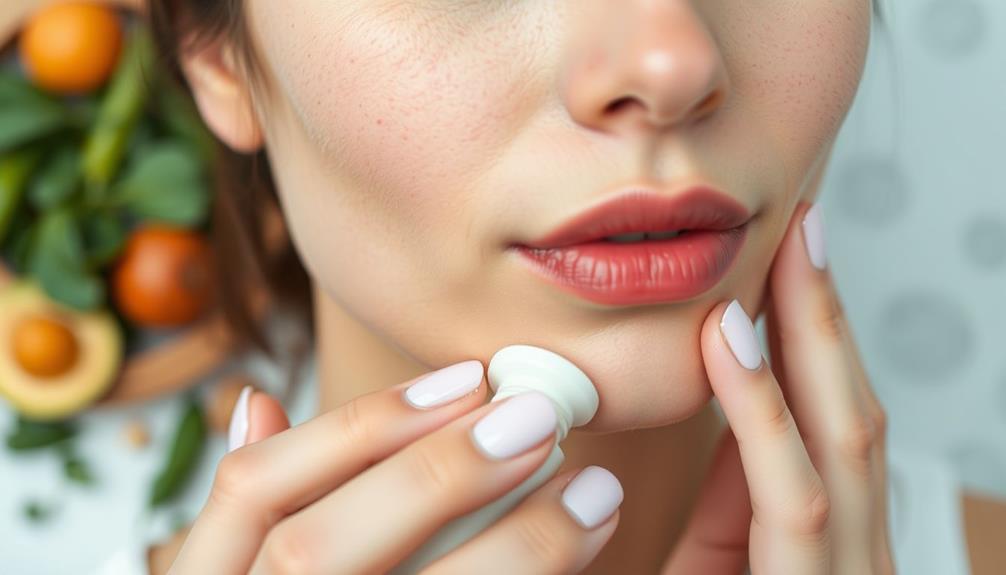
Using glycolic acid can lead to several risks and side effects, including skin irritation and increased sensitivity to sunlight. If you have sensitive skin, you might experience irritation, redness, itching, swelling, or even a burning sensation. These reactions can be uncomfortable and may deter you from continuing its use. It's vital to introduce glycolic acid gradually into your skincare routine, monitoring how your skin responds.
Overusing glycolic acid can exacerbate existing skin issues, leading to adverse reactions. If you have darker skin, you should be particularly cautious, as irritation or inflammation may result in hyperpigmentation. This risk underscores the need for careful consideration before using glycolic acid.
Additionally, higher concentrations of glycolic acid—especially those above 10%—should be used under professional supervision. This guarantees that you're minimizing serious skin reactions while maximizing safety.
Always remember that daily sunscreen use is imperative when using glycolic acid, as it can make your skin more vulnerable to UV damage. By being aware of these risks and side effects, you can make informed decisions about incorporating glycolic acid into your skincare routine.
Choosing the Right Products
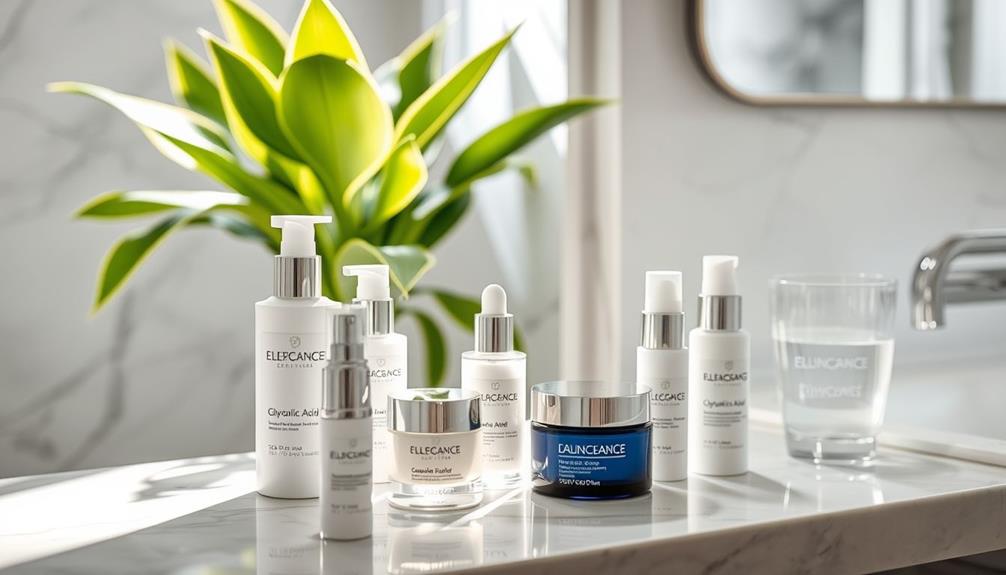
When selecting glycolic acid products, it's important to choose the right concentration and formulation to guarantee effective and safe use for your skin.
Start by opting for concentrations between 5% to 10% for at-home use. This range minimizes irritation while still providing effective exfoliation. Pay attention to the pH levels of the product, aiming for around 4, which promotes compatibility with your skin's natural pH and enhances the acid's effectiveness.
Here are some tips to keep in mind when choosing glycolic acid products:
- Begin with one product at a time to monitor your skin's response.
- Gradually increase usage frequency, starting with three times a week.
- Opt for leave-on formulations like serums or creams for longer contact time.
Application Tips and Best Practices
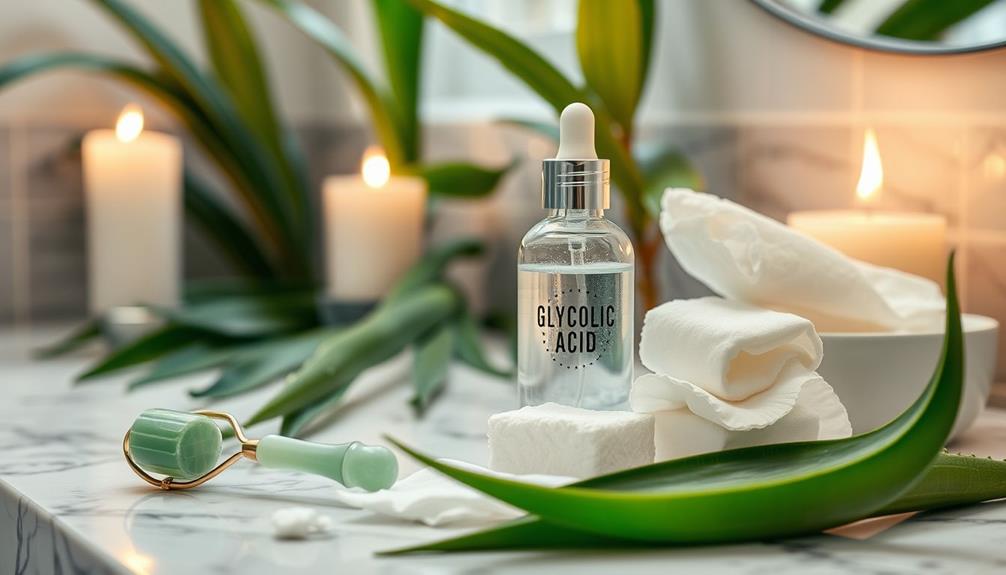
To get the most out of glycolic acid, apply it in the evening to minimize sun sensitivity and allow your skin to absorb its benefits overnight.
Start with products containing low concentrations (around 5-10%) to gauge your skin's tolerance and reduce the likelihood of skin irritation. Gradually increase usage as your skin adjusts.
When introducing glycolic acid into your skincare routine, do it one product at a time. This approach helps you effectively monitor your skin's response and avoid potential adverse effects.
For best results, consider leave-on formulations like serums or creams, which provide more extended benefits compared to wash-off products.
Always use a broad-spectrum sunscreen during the day to protect your skin from harmful UV rays.
Avoid mixing glycolic acid treatments with other strong exfoliants or retinoids initially, as this can heighten the risk of irritation.
Frequently Asked Questions
What Does Glycolic Acid Do for Your Face?
Glycolic acid gently exfoliates your skin, unclogs pores, and boosts collagen production. It helps fade dark spots and improves overall texture, leaving your face smoother, more radiant, and hydrated for a healthier appearance.
Does Glycolic Acid Remove Dark Spots?
Yes, glycolic acid can effectively remove dark spots. It exfoliates your skin, promoting cell turnover and fading hyperpigmentation. By using it consistently, you'll notice a more even skin tone and improved clarity over time.
Does Glycolic Acid Lighten the Skin?
Did you know that 60% of people notice brighter skin after regular glycolic acid use? It does lighten your skin by exfoliating dead cells and boosting cell turnover, making dark spots less noticeable over time.
Does Glycolic Acid Clear Your Skin?
Yes, glycolic acid clears your skin by exfoliating dead cells, unclogging pores, and promoting cell turnover. Regular use can help improve texture, reduce blemishes, and diminish acne scars, resulting in a clearer, healthier complexion.
Conclusion
In the garden of your skin, 10% glycolic acid acts like a diligent gardener, gently pruning away dead leaves to reveal vibrant blossoms beneath.
By embracing its power, you're inviting clarity, youthfulness, and a smoother texture to flourish.
Just remember to water your skin with hydration and shield it from the sun's harsh rays, ensuring your garden thrives.
With patience and care, you'll cultivate a radiant complexion that truly reflects the beauty within.

